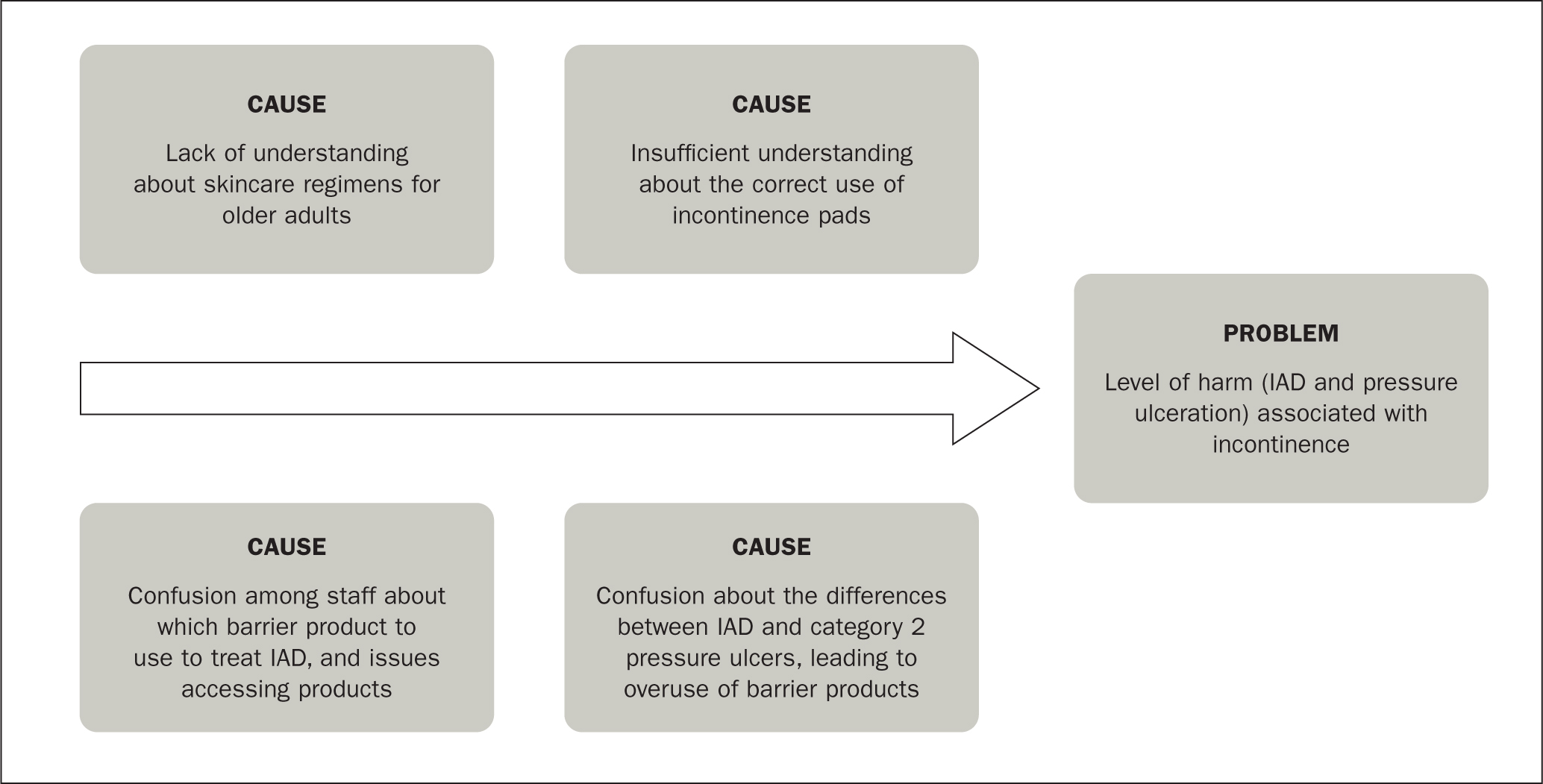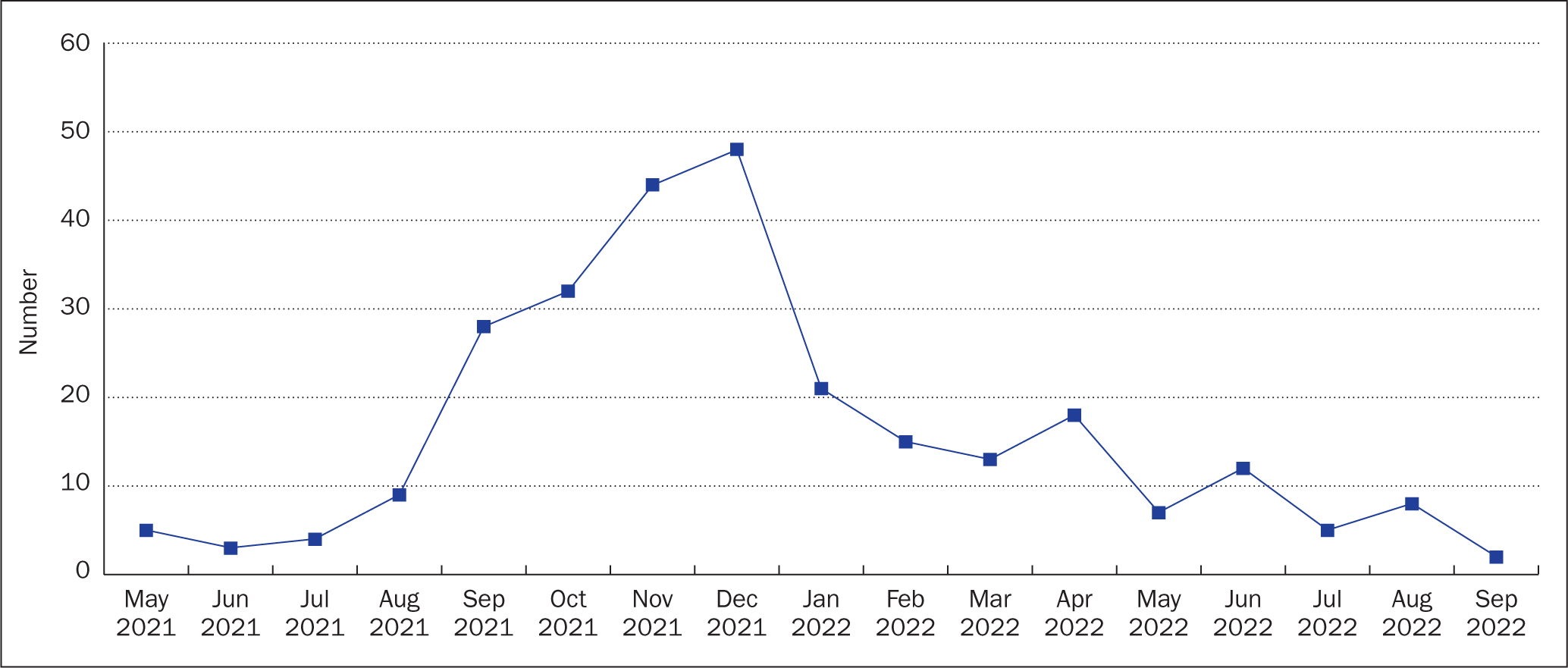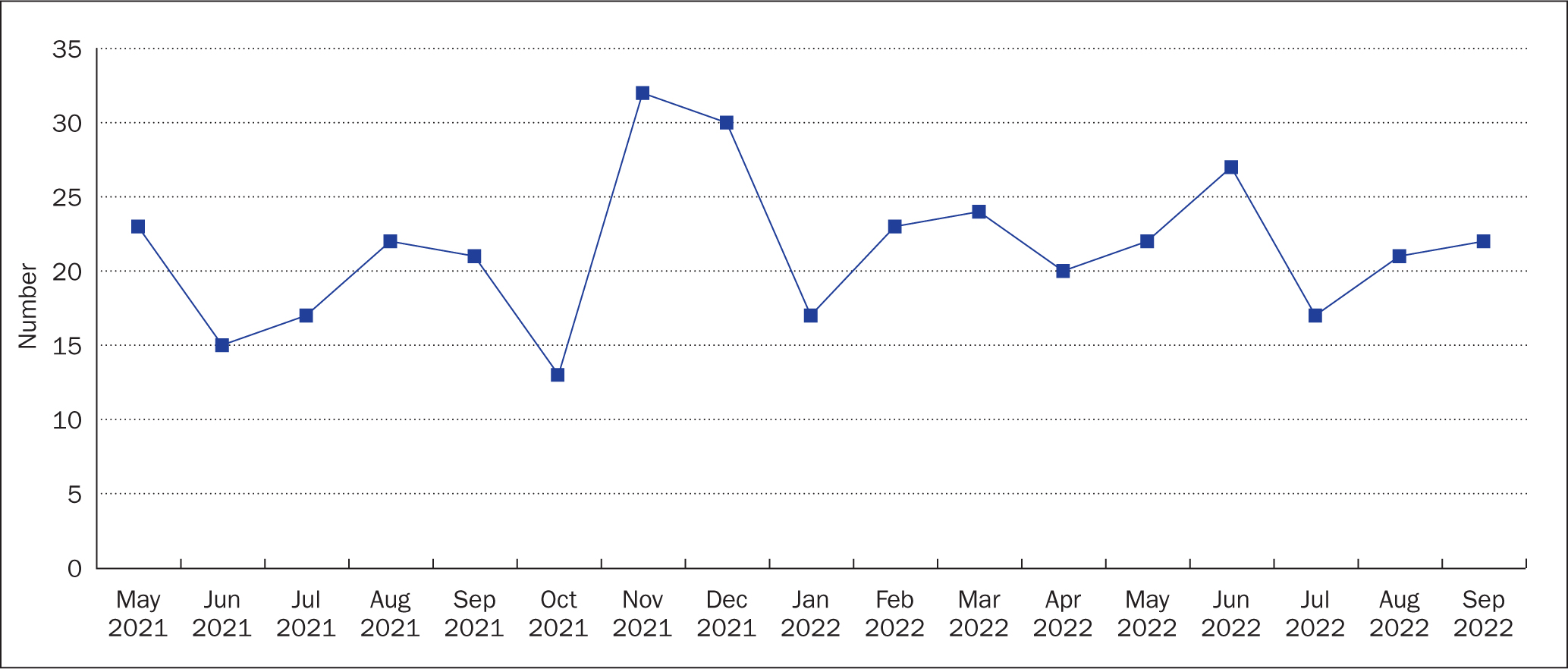The impact of pressure ulceration on patient quality of life can be catastrophic, as a result of the pain experienced, distress, depression and delayed recovery, (Office for Health Improvement and Disparities, 2022). Severe pressure ulcers (PUs) may lead to sepsis, renal failure and death (Berlowitz and Brienza, 2007; Sari et al, 2015). In addition, the financial burden to healthcare services is great, with the daily cost of managing PUs in the NHS estimated to be £3.8 million (NHS Improvement 2018a).
Older people are at an increased risk of developing PUs, due to factors such as: hip fractures, reduced mobility, dry skin, long-term conditions and faecal and urinary incontinence (Banharak et al, 2021; Office for Health Improvement and Disparities, 2022). Furthermore, older people are at an increased risk of developing incontinence-associated dermatitis (IAD), a type of moisture-associated skin damage (MASD), which presents as redness or partial-thickness skin erosion (Gray et al, 2007). This occurs because prolonged exposure to moisture due to incontinence leads to increased permeability of the skin, reduced skin barrier function, increased skin alkalinity and inflammation (Morris, 2011). It has also been established that there is a link between IAD and the subsequent development of PUs (Beeckman, 2017).
NHS England has introduced several initiatives to reduce pressure ulcer harm, to include reporting serious incidents through the Strategic Executive Information System (StEIS), which was recently replaced by the Patient Safety Incident Response Framework (PSIRF) (NHS England, 2022). NHS Improvement also developed PU and MASD reporting recommendations for all trusts in England (NHS Improvement, 2018a).
It is crucial that any person identified with continence issues should be assessed by a competent registered professional with knowledge of the continence assessment process, in order to reduce the risk of IAD and pressure ulceration. The task of assessing and managing incontinence is predominantly a nursing role, therefore it is important to examine this practice from a nursing perspective.
Within one NHS trust, in two acute hospital settings, four continence care nurse practitioners (CCNPs) were placed on a year's secondment across six older people's wards, in order to review staff practice in relation to continence assessment and management. A review group, led by the tissue viability service, was established to support the CCNPs with improvement strategies. The review group comprised: a member of the bladder and bowel service, four CCNPs, the tissue viability lead nurse, and three tissue viability nurse specialists. This quality improvement initiative formed one part of a Trust-wide pressure ulcer prevention improvement programme.
Aims of the improvement programme
- To understand the level of nursing knowledge in relation to continence assessment and IAD prevention and management
- To review current nursing practice on continence assessment, and IAD prevention and management
- To implement changes to improve continence assessments within elderly care, in order to reduce IAD and PU incidence.
Ethical considerations
This improvement programme was deemed exempt from ethics review according to local Trust policy.
Methods
The improvement programme
Following the appointment of four CCNPs, a project plan was developed by the lead tissue viability nurse, covering a 1-year period (July 2021-July 2022). A Plan, Do, Study, Act (PDSA) cycle was used to shape the four stages of the project (NHS England/NHS Improvement, 2022a).
Stages 1 and 2: ‘plan’ and ‘do’
A review group was established, to discuss the aims and intended outcomes of the improvement programme. Four CCNPs were supported by the tissue viability service and bladder and bowel service with training on continence assessment and management, IAD and PU prevention. The review group discussed the baseline data required to identify any knowledge gaps across six older people's wards, in relation to continence assessment, IAD and PU prevention. The information required was identified on a staff knowledge questionnaire comprising 10 short questions, enabling data to be collected in a standardised format. The CCNPs requested that nursing staff and healthcare assistants completed the anonymous staff knowledge questionnaires during July 2021, at the beginning of the project.
Stage 3: ‘study’
Following data collection, a ‘Fishbone tool’ was used to guide cause and effect analysis (Figure 1). This is a key diagnostic tool used in root cause analysis within improvement projects (NHS England/NHS Improvement, 2022b). This ‘Fishbone tool’ was used to guide the review group to identify themes in relation to knowledge issues among nurses and healthcare assistants. The root causes of the problem were discussed, with solutions proposed. Altogether, 58 questionnaires were returned.

Several themes were identified in relation to knowledge deficits, across all six wards. These included: incorrect skin cleansing regimens, incorrect use (including overuse) of barrier products to treat IAD, and inappropriate use of incontinence pads. In comparison, staff demonstrated good knowledge in relation to the following: recognition that IAD can increase the risk of pressure ulceration, the importance of repositioning to prevent PUs, and recognition that certain factors, such as constipation, can increase the risk of urinary incontinence.
The group agreed that the following factors were contributing to knowledge deficits:
- Lack of understanding about skin ageing, and why specific skincare regimens are recommended for older adults
- Issues obtaining the correct skin care products at ward level
- Insufficient understanding about the correct use of incontinence pads
- Confusion among staff about the differences between IAD and category 2 pressure ulceration, often leading to overuse use of barrier products
- Confusion among staff about which barrier product to choose (out of three), according to different levels of IAD severity, leading to incorrect use
The group discussed ideas, in order to create solutions to the problems identified.
Stage 4: ‘act’ and assess impact
A programme of training led by the CCNPs, to include bedside and ward-based sessions, was initiated across all six wards. The CCNPs and tissue viability service jointly developed five training cards with key messages, which were used for brief 5-minute staff training sessions at the bedside. The training included: defining IAD and the pathophysiology behind it, the differences between IAD and category 2 pressure ulceration, skin-cleansing regimens and correct use of incontinence aids. In addition, the Trust's IAD management pathway was updated and promoted to ward staff by the CCNPs, the tissue viability service, and through external company training. The pathway was condensed to include just two products sourced from a different company. The aim of this change in product was to reduce confusion among staff about the barrier products available, and to ensure an adequate supply of the product.
Furthermore, the CCNPs were tasked with promoting good practice in relation to thorough continence assessments, and correct use of incontinence pads. This training was supported by an external company representative, with the development of an educational video for staff.
During this period of action and refinement (October 2021-February 2022), the CCNPs continued to promote training and resources to ward staff, to include the numerous resources available to ward teams on the tissue viability and bladder and bowel pages of the Trust's intranet site. Ward managers were encouraged by the review group to perform a training needs analysis, to identify additional training required at ward level.
A multidisciplinary team approach was essential, with communication constant between members of the review group and the wider team during this period.
In order to assess the impact of the improvement work, staff knowledge questionnaires were re-issued following this period of action. Of the six older persons' wards included, five wards (57 respondents) provided the review group with completed questionnaires post-project (Table 1).
Table 1. Results of staff knowledge questionnaires
| Theme | Percentage of staff who answered correctly – pre project (n=58) | Percentage of staff who answered correctly – post project (n=57) | Percentage knowledge increase/decrease |
|---|---|---|---|
| Displays understanding that incontinence-associated dermatitis (IAD) can increase the risk of pressure ulceration | 92% | 100% | ▴8% |
| Displays understanding that soap and water should not be used to cleanse fragile skin | 59% | 88% | ▴29% |
| Displays understanding about management of severe IAD according to Trust pathway | 53% | 37% | ▾16% |
| Displays understanding about which product should be used to cleanse skin as per Trust pathway | 62% | 85% | ▴23% |
| Demonstrates understanding that not all patients with moisture-associated skin damage (MASD) require high-spec pressure-relieving mattresses | 65% | 67% | ▴2% |
| Demonstrates understanding that constipation can increase the risk of urinary incontinence | 83% | 87% | ▴5% |
| Demonstrates understanding about the referral triggers to tissue viability | 78% | 90% | ▴12% |
| Demonstrates understanding that repositioning is important for patients with MASD | 100% | 97% | ▾3% |
| Demonstrates understanding that patients with urinary incontinence should be encouraged to drink fluids | 92% | 93% | ▴1% |
| Shows understanding about the correct use of incontinence pads | 82% | 76% | ▾6% |
The review group identified that in all but three topics, there had been an increase in staff knowledge. Most noticeable was an increase in knowledge about skin cleansing. A slight reduction in knowledge among staff in relation to the importance of repositioning patients with IAD was identified (3% decrease). However, further investigation showed that this question had been left unrecorded by the responders; therefore the group agreed that this was not a true reflection of knowledge level in relation to this topic.
The review group established that further focused work was required to support an improvement in staff knowledge in relation to:
- Correct use of incontinence pads
- Management of severe IAD according to Trust pathway
It was highlighted that education was ongoing in relation to the Trust's new IAD management pathway, to include information about new products. In addition, improvement work was underway to standardise the Trust's incontinence pad formulary.
Monthly data on the incidence of healthcare-associated IAD and pressure ulcers (category 1 and above) were captured from the Trust's Datix incident reporting system. Data ere extracted from May 2021 (2 months prior to the project), until September 2022 (2 months after the project ended).
Figure 2 shows a decrease in the incidence of IAD from January 2022 onwards. At the beginning of the project (July 2021), it was identified that two of the six wards had not historically reported IAD incidents. Education was provided by the CCNPs, and subsequent reporting from both wards led to an initial increase between September 2022 and January 2022. It was concluded that the incidence of IAD prior to July 2021 was likely to be higher than the data captured suggest, due to the historical absence of reporting from these two wards.

Figure 3 shows that the incidence of healthcare-associated PUs (all categories) did not reduce significantly, during or after the project. Further quality improvement work is ongoing to support a reduction, underpinned by the ASSKING bundle (NHS Improvement, 2018b).

Findings and discussion
At the beginning of this quality improvement programme, it was apparent that nursing staff did not always demonstrate a consistent approach to continence management, IAD prevention and management. Inadequate assessment and management of incontinence may lead to the development of IAD or PUs, predisposing the patient to risk of wound contamination from urine and faeces, and subsequent infection (Ousey and Gillibrand, 2010).
In addition, it was identified that staff found it difficult to distinguish between category 2 pressure ulcers and moisture lesions, leading to incorrect management plans. The European Pressure Injury Advisory Panel, National Pressure Injury Advisory Panel and Pan Pacific Pressure Injury Alliance (2019) define a pressure ulcer as: localised damage to the skin or underlying tissue, usually over a bony prominence, resulting from sustained pressure, or pressure in combination with shear. A category 2 pressure ulcer is defined as: partial thickness skin loss without slough, which may present as an intact or open blister, and wound edges tend to be distinct. In comparison, moisture lesions usually have irregular edges, and can be dispersed throughout the area exposed to moisture, typically affecting the perineum and perigenital areas, gluteal fold, buttocks, thighs and lower back (Fletcher et al, 2020).
All category 3, category 4, unstageable and deep tissue injury PU data were validated by the tissue viability team throughout the improvement programme, however, one limitation is that category 2 and IAD incidence data were not initially validated. Following a period of action, which included training on the differences between IAD and category 2 PUs, the CCNPs began to validate the IAD and category 2 PU incidence data on the Datix reporting system in December 2021. The accuracy of the data at the beginning of the project is therefore debatable.
The purpose of the project was to review current nursing practice on continence assessment, IAD prevention and management, in order to implement changes to improve continence assessments across six older people's wards, to reduce IAD and PU incidence. Staff knowledge was found to have increased as a result of the project, particularly in relation to skin cleansing.
The skin's pH is naturally acidic, which is important for antimicrobial defence, and to maintain a barrier against the loss of tissue water (Moncrieff et al, 2015). Skin barrier integrity typically diminishes from the age of 60, with the skin becoming thin and more fragile with a paper-like appearance, due to loss of collagen and elastin (Voegeli, 2007). The skin becomes dry and flaky due to a reduction in the number of sweat glands, making it more vulnerable to cracking. This increases the risk of bacterial invasion (Wounds UK, 2012). Many soap products are alkaline, which can subsequently damage skin barrier function, cause irritation and increase the risk of infection and skin breakdown (Kirsner and Froelich, 1998). Once impaired, the skin is less able to withstand mechanical trauma or maintain immunological function (Moncrieff et al, 2015).
It is therefore crucial that appropriate skin-cleansing products are used, particularly for older adults, in order to maintain skin barrier function. Skin cleansing with an emollient (a non-cosmetic moisturiser) has been found to lower skin pH, supporting the prevention of skin tissue water loss, infection and skin damage (Beeckman et al, 2009).
This quality improvement project has raised awareness of the key elements of continence assessment, IAD prevention and management, to include the importance of emollient therapy as part of a structured skin care regimen. Owing to the absence of Trust guidance on skin care management, a skincare guideline was subsequently developed, in order to support a consistent approach to skin cleansing and continence/IAD management. A further follow-up study is required, to establish the impact of the guideline.
It is intended that further work, to include standardisation of continence pads in the acute setting, and a restructure of the continence assessment documentation, will support staff to ensure a robust continence assessment and management process is in place.
By using four key stages and a cause and effect ‘Fishbone’ tool to shape this quality improvement initiative, the review group could promptly focus on the root cause of the problem, to collectively create solutions.
There are some limitations to the programme, since only 58 staff knowledge questionnaires were completed pre project, and 57 post project. The questionnaires were completed by both healthcare assistants and nurses post project; however, job titles were not identified for the pre-project responses, therefore comparisons could not be made in relation to knowledge levels between staff groups. In addition, one ward did not return any questionnaires post project, therefore it could not be established if knowledge had improved specifically on this ward.
The improvement project demonstrated a decrease in the incidence of IAD from January 2022 onwards. Prior to September 2021, two wards had not historically reported IAD, therefore a peak in the incidence data is apparent around this time. The group concluded that the continued decrease in IAD incidence after December 2021 was largely due to the increase in staff knowledge demonstrated during the project.
Further improvement work is currently ongoing within the Trust, in order to support a reduction in the incidence of pressure ulceration. A subsequent follow-up study is required in order to establish the efficacy of interventions.
Conclusion
Nurses have a pivotal role to play in the assessment and management of incontinence, in order to decrease patient harm. The strategies used within this quality improvement initiative could be applied to other areas, in order to support a change in practice in relation to continence assessment and management. Further evaluation is required to establish if the changes implemented have led to a sustainable improvement in staff knowledge and a continued reduction in the incidence of IAD.
KEY POINTS
- Older people are at greater risk of developing skin damage due to incontinence
- Skin barrier integrity typically reduces after the age of 60 years, due to loss of collagen and elastin, and a reduction in the number of sweat glands
- An understanding of specific risk factors predisposing older people to skin damage will enable clinicians to initiate early incontinence-associated dermatitis prevention and pressure ulcer preventative strategies
- Nurses have an important role to play in the assessment and management of incontinence, in order to reduce the risk of skin damage occurring
CPD reflective questions
- What can you do to support incontinence-associated dermatitis and pressure ulcer reduction in your own clinical setting?
- Do you feel that the importance of continence assessment and management is fully understood in your clinical area?
- Are there any points identified within this article that you could further reflect on and consider with your wider team?


